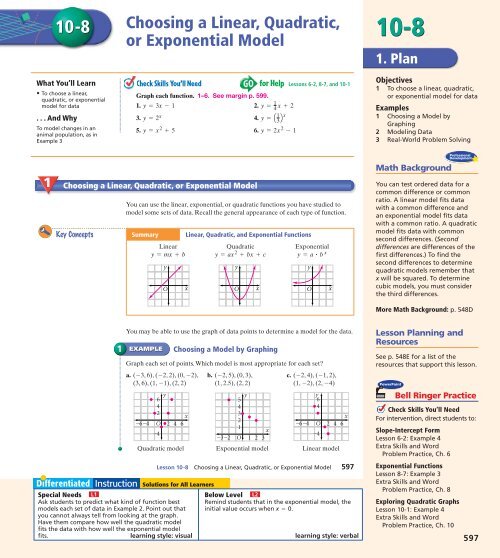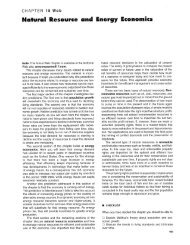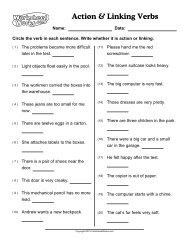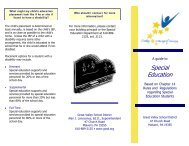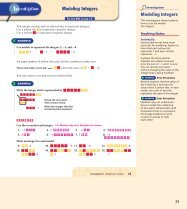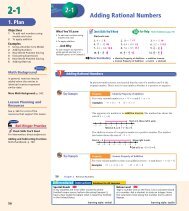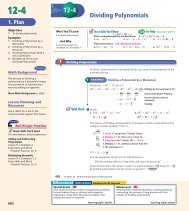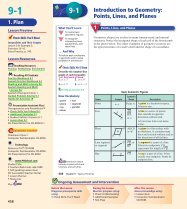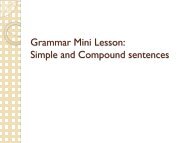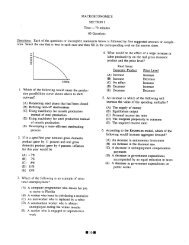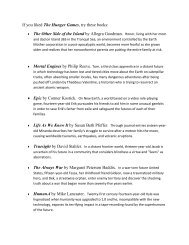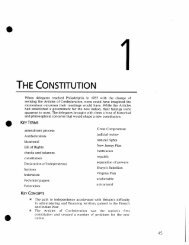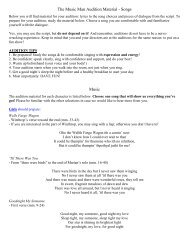Alg 1 TE Lesson 10-8
Alg 1 TE Lesson 10-8
Alg 1 TE Lesson 10-8
Create successful ePaper yourself
Turn your PDF publications into a flip-book with our unique Google optimized e-Paper software.
<strong>10</strong>-8<br />
What You’ll Learn<br />
• To choose a linear,<br />
quadratic, or exponential<br />
model for data<br />
. . . And Why<br />
To model changes in an<br />
animal population, as in<br />
Example 3<br />
Choosing a Linear, Quadratic,<br />
or Exponential Model<br />
Check Skills You’ll Need GO for Help<br />
Graph each function. 1–6. See margin p. 599.<br />
1. y = 3x - 1 2. y =<br />
1<br />
4 x + 2<br />
3. y = 2 x 4. y = Q 1 3 Rx<br />
5. y = x 2 + 5 6. y = 2x 2 - 1<br />
<strong>Lesson</strong>s 6-2, 8-7, and <strong>10</strong>-1<br />
<strong>10</strong>-8<br />
1. Plan<br />
Objectives<br />
1 To choose a linear, quadratic,<br />
or exponential model for data<br />
Examples<br />
1 Choosing a Model by<br />
Graphing<br />
2 Modeling Data<br />
3 Real-World Problem Solving<br />
Math Background<br />
Part 1 1 Choosing a Linear, Quadratic, or Exponential Model<br />
You can use the linear, exponential, or quadratic functions you have studied to<br />
model some sets of data. Recall the general appearance of each type of function.<br />
Key Concepts Summary Linear, Quadratic, and Exponential Functions<br />
Linear Quadratic Exponential<br />
y = mx + b y = ax 2 + bx + c y = a ? b x<br />
y<br />
O<br />
x<br />
y<br />
O<br />
x<br />
y<br />
O<br />
x<br />
You can test ordered data for a<br />
common difference or common<br />
ratio. A linear model fits data<br />
with a common difference and<br />
an exponential model fits data<br />
with a common ratio. A quadratic<br />
model fits data with common<br />
second differences. (Second<br />
differences are differences of the<br />
first differences.) To find the<br />
second differences to determine<br />
quadratic models remember that<br />
x will be squared. To determine<br />
cubic models, you must consider<br />
the third differences.<br />
More Math Background: p. 548D<br />
1<br />
You may be able to use the graph of data points to determine a model for the data.<br />
EXAMPLE<br />
Choosing a Model by Graphing<br />
Graph each set of points. Which model is most appropriate for each set?<br />
a. (-3, 6), (-2, 2), (0, -2), b. (-2, 5), (0, 3), c. (-2, 4), (-1, 2),<br />
(3, 6), (1, -1), (2, 2) (1, 2.5), (2, 2) (1, -2), (2, -4)<br />
y<br />
6<br />
y<br />
5<br />
y<br />
6<br />
4<br />
4<br />
4<br />
64<br />
2<br />
x<br />
3<br />
x<br />
2<br />
O 2 4 6<br />
64<br />
O 2 4 6<br />
1<br />
x<br />
4<br />
4<br />
32<br />
O 1 2 3<br />
Quadratic model Exponential model Linear model<br />
<strong>Lesson</strong> Planning and<br />
Resources<br />
See p. 548E for a list of the<br />
resources that support this lesson.<br />
PowerPoint<br />
Bell Ringer Practice<br />
Check Skills You’ll Need<br />
For intervention, direct students to:<br />
Slope-Intercept Form<br />
<strong>Lesson</strong> 6-2: Example 4<br />
Extra Skills and Word<br />
Problem Practice, Ch. 6<br />
<strong>Lesson</strong> <strong>10</strong>-8 Choosing a Linear, Quadratic, or Exponential Model 597 Exponential Functions<br />
<strong>Lesson</strong> 8-7: Example 3<br />
Extra Skills and Word<br />
Special Needs L1<br />
Below Level L2<br />
Problem Practice, Ch. 8<br />
Ask students to predict what kind of function best Remind students that in the exponential model, the Exploring Quadratic Graphs<br />
models each set of data in Example 2. Point out that initial value occurs when x = 0.<br />
<strong>Lesson</strong> <strong>10</strong>-1: Example 4<br />
you cannot always tell from looking at the graph.<br />
Extra Skills and Word<br />
Have them compare how well the quadratic model<br />
Problem Practice, Ch. <strong>10</strong><br />
fits the data with how well the exponential model<br />
fits.<br />
learning style: visual learning style: verbal<br />
597
2. Teach<br />
Guided Instruction<br />
1<br />
Visual Learners<br />
Help students remember the<br />
general appearance of each<br />
function by drawing the<br />
following on the board:<br />
2<br />
EXAMPLE<br />
q adratic<br />
y ax sq ared bx c<br />
e ponential<br />
y a · b<br />
inear<br />
y mx b<br />
EXAMPLE<br />
Technology Tip<br />
Students can use a graphing<br />
calculator to graph the data,<br />
determine the type of function<br />
that best fits the data, and write<br />
an equation to model the data.<br />
Press<br />
to enter the data<br />
in lists. Press 2nd STAT PLOT<br />
9 to graph the points.<br />
You can see that the model is not<br />
linear.<br />
Quick Check<br />
1<br />
Graph each set of points. Which model is most appropriate for each set?<br />
a. (-1.5, -2), (0, 2), (1, 4), (2, 6) b. (-1, 1), (0, 0), (1, 1), (2, 4)<br />
c. (-1, 0.5), (0, 1), (1, 2), (2, 4) a–c. See margin.<br />
You can also analyze data numerically to find the best model.<br />
In <strong>Lesson</strong> 5-6, you learned that the terms of an arithmetic sequence have a<br />
common difference. You can model an arithmetic sequence with a linear function.<br />
1<br />
1<br />
1<br />
1<br />
The y-coordinates have a common difference of 4. A linear model fits the data.<br />
In <strong>Lesson</strong> 8-6, you learned that the terms of a geometric sequence have a common<br />
ratio. You can model a geometric sequence with an exponential function.<br />
1<br />
1<br />
1<br />
1<br />
x<br />
2 2<br />
1 2<br />
0 6<br />
1 <strong>10</strong><br />
x<br />
2<br />
1<br />
0<br />
The y-coordinates have a common ratio of 3. An exponential model fits the data.<br />
y<br />
2 14<br />
y<br />
1<br />
9<br />
1<br />
3<br />
1<br />
1 3<br />
2 9<br />
4<br />
4<br />
4<br />
4<br />
3<br />
3<br />
3<br />
3<br />
Data from quadratic functions show a different pattern. For linear data, the first<br />
differences are the same. For quadratic data, the second differences are the same.<br />
If data have a common second difference, then you can model them with a<br />
quadratic function.<br />
x<br />
y<br />
1<br />
1<br />
1<br />
1<br />
1<br />
1 16<br />
0 2<br />
1 2<br />
2 4<br />
3 20<br />
4 46<br />
14<br />
4<br />
6<br />
16<br />
26<br />
<strong>10</strong><br />
<strong>10</strong><br />
<strong>10</strong><br />
<strong>10</strong><br />
first differences<br />
second differences<br />
The y-coordinates have a common second difference of <strong>10</strong>. A quadratic<br />
model fits the data.<br />
598 Chapter <strong>10</strong> Quadratic Equations and Functions<br />
598<br />
Advanced Learners L4<br />
Have students describe what the graph in Example 3<br />
would look like if the frog population were<br />
increasing, rather than decreasing.<br />
learning style: verbal<br />
English Language Learners ELL<br />
Be sure students understand that when they are<br />
modeling data they are finding a function that will<br />
enable them to predict data points that are not<br />
provided.<br />
learning style: verbal
x y<br />
1 20<br />
0 8<br />
1 3.2<br />
2 1.28<br />
3 0.512<br />
2<br />
EXAMPLE<br />
Modeling Data<br />
a. Which kind of function best models the data at the left? Write an equation to<br />
model the data.<br />
Step 1 Graph the data.<br />
8<br />
7<br />
6<br />
5<br />
4<br />
3<br />
2<br />
1<br />
O<br />
y<br />
x<br />
1 2 3 4 5 6 7 8 9<br />
1<br />
1<br />
1<br />
1<br />
Step 2 The data appear to suggest an<br />
exponential model. Test for a<br />
common ratio.<br />
x<br />
1<br />
0<br />
1<br />
2<br />
3<br />
20<br />
8<br />
There is a common ratio, 0.4.<br />
y<br />
3.2<br />
1.28<br />
0.512<br />
8 20 0.4<br />
3.2 8 0.4<br />
1.28 3.2 0.4<br />
0.512 1.28 0.4<br />
To determine if a quadratic or<br />
exponential function best models<br />
the data, use the calculator to<br />
find each equation that best fits<br />
the data. Press 5<br />
Y= 5 .<br />
The quadratic model will appear<br />
on the graph. To find the<br />
exponential model, follow the<br />
same steps except press 0 instead<br />
of the first 5, and scroll to Y 2 =<br />
after you press Y= . Now the<br />
exponential model will appear.<br />
The exponential model passes<br />
through more of the data<br />
points. Press Y= and write<br />
the exponential equation after<br />
Y 2 as y = 8 ? 0.4 x .<br />
Step 3 Write an exponential model. Step 4 Test two points other than (0, 8).<br />
Relate y = a ? b x y = 8 ? 0.4 1 y = 8 ? 0.4 3<br />
PowerPoint<br />
Additional Examples<br />
x y<br />
0 0<br />
1 0.3<br />
2 1.2<br />
3 2.7<br />
4 4.8<br />
Define Let a = the initial value, 8. y = 8 ? 0.4 y = 8 ? 0.064<br />
Let b = the decay factor, 0.4. y = 3.2 y = 0.512<br />
Write y = 8 ? 0.4 x (1, 3.2) and (3, 0.512) are both data points.<br />
The equation y = 8 ? 0.4 x models<br />
the data.<br />
b. Which kind of function best models the data at the left? Write an equation to<br />
model the data.<br />
Step 1 Graph the data.<br />
6<br />
5<br />
4<br />
3<br />
2<br />
1<br />
2 O<br />
2<br />
y<br />
x<br />
1 2 3 4 5 6 7 8<br />
Step 2 The data appear to be quadratic.<br />
Test for a common second<br />
difference.<br />
1<br />
1<br />
1<br />
1<br />
x<br />
0<br />
1<br />
0<br />
y<br />
0.3<br />
2 1.2<br />
3 2.7<br />
4 4.8<br />
0.3<br />
0.9<br />
1.5<br />
2.1<br />
0.6<br />
0.6<br />
0.6<br />
There is a common second difference, 0.6.<br />
1 Graph each set of points.<br />
Which model is most appropriate<br />
for each set?<br />
a. (-2, 1.45), (0, 3), (1, 4) (2, 6)<br />
exponential<br />
b. (-2, -2), (0, 2), (1, 4), (2, 6)<br />
linear<br />
c. (-2, 11), (-1, 5), (0, 3), (1, 5),<br />
(2, 11) quadratic<br />
6.<br />
2<br />
page 598 Quick Check<br />
1a. y linear<br />
6<br />
y<br />
4<br />
2<br />
O<br />
x<br />
2<br />
Step 3 Write a quadratic model. Step 4 Test two points other than<br />
(2, 1.2) and (0, 0).<br />
y = ax 2 y = 0.3(3) 2 y = 0.3(4) 2<br />
1.2 = a(2) 2 Use a point other<br />
than (0, 0) to find a.<br />
y = 0.3 ? 9 y = 0.3 ? 16<br />
y = 2.7 y = 4.8<br />
1.2 = 4a Simplify.<br />
0.3 = a Divide each side by 4. (3, 2.7) and (4, 4.8) are both data points.<br />
y = 0.3x 2 Write a quadratic The equation y = 0.3x 2 models the data.<br />
function.<br />
4<br />
2<br />
O<br />
2<br />
b. y quadratic<br />
4<br />
x<br />
2<br />
2<br />
<strong>Lesson</strong> <strong>10</strong>-8 Choosing a Linear, Quadratic, or Exponential Model 599<br />
O<br />
x<br />
2<br />
page 597 Check Skills You’ll Need<br />
1. y 2. y<br />
3. y<br />
4. y 5.<br />
2<br />
O x<br />
1 1<br />
1<br />
2 O 2<br />
x<br />
2<br />
8<br />
4<br />
O<br />
2<br />
x<br />
2<br />
8<br />
4<br />
O<br />
x<br />
1<br />
2<br />
y<br />
8<br />
4<br />
O<br />
x<br />
2<br />
c. y exponential<br />
4<br />
2<br />
x<br />
O 2<br />
599
PowerPoint<br />
Additional Examples<br />
2 Which kind of data best<br />
models the data below? Write<br />
an equation to model the data.<br />
a.<br />
x y<br />
0 0<br />
1 1.4<br />
2 5.6<br />
3 12.6<br />
4 22.4<br />
b.<br />
quadratic; y ≠ 1.4x 2<br />
x<br />
-1 4<br />
0 2<br />
1 1<br />
exponential; y ≠ 2 ? 0.5 x<br />
3 Suppose you are studying deer<br />
that live in an area. The data<br />
below were collected by a local<br />
conservation organization. It<br />
indicates the number of deer<br />
estimated to be living in the area<br />
over a five-year period. Determine<br />
which kind of function best<br />
models the data. Write an<br />
equation to model the data.<br />
exponential; y ≠ 90 ? 0.77 x<br />
Resources<br />
• Daily Notetaking Guide <strong>10</strong>-8<br />
L3<br />
• Daily Notetaking Guide <strong>10</strong>-8—<br />
Adapted Instruction L1<br />
Closure<br />
y<br />
2 0.5<br />
3 0.25<br />
Estimated<br />
Year Population<br />
0 90<br />
1 69<br />
2 52<br />
3 40<br />
4 31<br />
Real-World<br />
Quick Check<br />
Connection<br />
Frog populations around the<br />
world have been declining<br />
over the past 20 years.<br />
2<br />
3<br />
Which kind of function best models the data in each table? Write an equation to<br />
model the data.<br />
a.<br />
x y<br />
b.<br />
x y<br />
c.<br />
x y<br />
0 4<br />
1<br />
0<br />
0 0<br />
2<br />
1 4.4<br />
1 1<br />
1 0.5<br />
2 4.84<br />
1<br />
2 2<br />
2 1<br />
2<br />
3 5.324<br />
3 4.5<br />
3 2<br />
4 5.8564<br />
4 8<br />
exponential; y ≠ 4 ? 1.1 x 1 1<br />
linear; y ≠ x ± quadratic; y ≠– 1 x 2<br />
2 2<br />
2<br />
While real-world data seldom fall exactly into linear, exponential, or quadratic<br />
patterns, you can find a best-possible model.<br />
EXAMPLE Real-World Problem Solving<br />
Zoology Suppose you are studying frogs that live in a<br />
nearby wetland area. The data at the right were collected by<br />
a local conservation organization. They indicate the number<br />
of frogs estimated to be living in the wetland area over a<br />
five-year period. Determine which kind of function best<br />
models the data. Write an equation to model the data.<br />
Step 1 Graph the data to decide which model is<br />
most appropriate.<br />
Population<br />
Step 2 Test for a common ratio.<br />
1<br />
1<br />
1<br />
1<br />
120<br />
80<br />
40<br />
0<br />
1 2 3 4 5 6<br />
Year<br />
Year<br />
0<br />
1<br />
2<br />
3<br />
4<br />
Estimated<br />
Population<br />
120<br />
<strong>10</strong>1<br />
86<br />
72<br />
60<br />
The graph curves, and it does not look<br />
quadratic. It may be exponential.<br />
The population of frogs is roughly 0.84 times its value the previous year.<br />
Step 3 Write an exponential model.<br />
Relate y = a ? b x<br />
Define Let a = the initial value, 120.<br />
Let b = the decay factor, 0.84.<br />
Write y = 120 ? 0.84 x<br />
<strong>10</strong>1 120 0.84<br />
86 <strong>10</strong>1 0.85<br />
72 86 0.84<br />
60 72 0.83<br />
Year<br />
0<br />
1<br />
2<br />
3<br />
4<br />
The common ratio is<br />
roughly 0.84.<br />
Estimated<br />
Population<br />
120<br />
<strong>10</strong>1<br />
86<br />
72<br />
60<br />
Ask students how to choose a<br />
linear, quadratic, or exponential<br />
model for data. First graph the<br />
data to see if the graph is linear<br />
or if it curves. Then look for a<br />
best fit model.<br />
600 Chapter <strong>10</strong> Quadratic Equations and Functions<br />
600
Quick Check<br />
EXERCISES<br />
Practice and Problem Solving<br />
A<br />
GO<br />
Practice by Example<br />
for<br />
Help<br />
Example 1<br />
(page 597)<br />
Step 4 Test two points other than (0, 120).<br />
y = 120 ? 0.84 3 y = 120 ? 0.84 4<br />
y < 71 y < 60<br />
The point (3, 71) is close to the data point (3, 72). The predicted value (4, 60)<br />
matches the corresponding data point. The equation y = 120 ? 0.84 x models<br />
the data.<br />
Year Profit (dollars)<br />
3 The profits of a small company are shown<br />
0<br />
0<br />
in the table at the right. Let x = 0 correspond<br />
1 5,000<br />
to the year 2000.<br />
2 20,000<br />
a. Determine which kind of function best models<br />
the data. quadratic<br />
3 44,000<br />
b. Write an equation to model the data. y ≠ 5000x 2 4 79,000<br />
For more exercises, see Extra Skill and Word Problem Practice.<br />
1–6. See<br />
Graph each set of points. Which model is most appropriate for each set? back of<br />
book.<br />
1. (-2, -3), (-1, 0), (0, 1), (1, 0), (2, -3) 2. (-2, -8), (0, -4), (3, 2), (5, 6)<br />
3. (-3, 6), (-1, 0), (0, -1), (1, -1.5) 4. (-2, 5), (-1, -1), (0, -3), (1, -1), (2, 5)<br />
5. Q-2, 25<br />
8<br />
, -1, 25<br />
2<br />
9<br />
R Q<br />
3<br />
R, (0, -5), (2, 3) 6. (-3, 8), (-1, 6), (0, 5), (2, 3), (3, 2)<br />
3. Practice<br />
Assignment Guide<br />
1<br />
A B 1-27<br />
C Challenge 28-29<br />
Test Prep 30-33<br />
Mixed Review 34-48<br />
Homework Quick Check<br />
To check students’ understanding<br />
of key skills and concepts, go over<br />
Exercises 8, 14, 17, 18, 20.<br />
Error Prevention!<br />
Exercises 1–6 Be sure students do<br />
not quickly determine that the<br />
best model is exponential as soon<br />
as they see that the graph is not<br />
linear. They need to graph all<br />
points to see if the graph is a<br />
quadratic model.<br />
Example 2<br />
(page 599)<br />
Example 3<br />
(page 600)<br />
Which kind of function best models the data in each table? Write an equation to<br />
model the data.<br />
7. x y<br />
8. x y<br />
9. x y<br />
0 0<br />
0 5<br />
0 0<br />
1 1.5<br />
1 3<br />
1 2.8<br />
2 6<br />
2 1<br />
2 11.2<br />
3 13.5<br />
3 1<br />
3 25.2<br />
4 24<br />
4 3<br />
4 44.8<br />
quadratic; y ≠ 1.5x 2 linear; y ≠ 2x – 5 quadratic; y ≠ 2.8x 2<br />
<strong>10</strong>. x y 11. x y 12. x y<br />
0<br />
1<br />
1 1.2<br />
2 1.44<br />
3 1.728<br />
0<br />
5<br />
1 2<br />
2 0.8<br />
3 0.32<br />
4 2.0736<br />
4 0.128<br />
4 0<br />
exponential; y ≠ 1 ? 1.2 x exponential; y ≠ 5 ? 0.4 x 1<br />
linear; y ≠– 2 x ± 2<br />
13. The table at the right shows the end-of-themonth<br />
balance in a checking account.<br />
Month Balance (dollars)<br />
a. Graph the data. Does the graph suggest a<br />
linear, exponential, or quadratic model?<br />
1<br />
2<br />
58<br />
123<br />
b. Find the differences of consecutive terms.<br />
3<br />
187<br />
Are they roughly the same? 65, 64, 64; yes<br />
c. Estimate a common difference based on<br />
4<br />
251<br />
your answer to part (b). 64<br />
d. Write an equation to model the data. y ≠ 64x – 5<br />
a. See back of book.<br />
0<br />
2<br />
1 1.5<br />
2 1<br />
3 0.5<br />
<strong>Lesson</strong> <strong>10</strong>-8 Choosing a Linear, Quadratic, or Exponential Model 601<br />
GPS<br />
Enrichment<br />
Guided Problem Solving<br />
Reteaching<br />
Adapted Practice<br />
Practice<br />
© Pearson Education, Inc. All rights reserved.<br />
Name Class Date<br />
Practice <strong>10</strong>-9<br />
Choosing a Linear, Quadratic, or Exponential Model<br />
Which kind of function best models the data? Write an equation to model<br />
the data.<br />
1. (-1, 3), (1, 3), (3, 27), (5, 75), (7, 147) 2. (-2, 4), (-1, 2), (0, 0), (1, -2), (2, -4)<br />
3. ¢ 22, ≤, ¢ 21, 1 ≤, (0, 1), (1, 4), (2, 16) 4. (-6, -1), (-3, 0), (0, 1), (3, 2), (6, 3)<br />
16<br />
1 4<br />
5. ¢ 22, 1 3<br />
≤,(-1, 1), (0, 3), (1, 9), (2, 27) 6. (-4, -32), (-2, -8), (0, 0), (2, -8), (4, -32)<br />
7. 8. 9.<br />
x y<br />
x y<br />
-3<br />
9<br />
2<br />
-2 2<br />
1<br />
-1<br />
2<br />
0 0<br />
<strong>10</strong>. 11. 12.<br />
x y<br />
x y<br />
0 -2<br />
1 -8<br />
2 -32<br />
3 -128<br />
13. ¢ 22, ≤, ¢ 21, ≤, ¢ 0, 1 ≤, ¢ 1, 1 ≤, ¢ 2, 1 ≤<br />
3<br />
1 1 3 3 3 3<br />
14. ¢ 21, 2 1 ≤, ¢ 0, 2 1 ≤, (1, -1), (2, -2), (3, -4)<br />
4 2<br />
15. The cost of shipping computers from a warehouse is given in the table below.<br />
Number of Computers 50 75 <strong>10</strong>0 125<br />
Cost (dollars) 1700 2500 3300 4<strong>10</strong>0<br />
a. Determine which kind of function best models the data.<br />
b. Write an equation to model the data.<br />
-1 -2<br />
0 -4<br />
1 -6<br />
2 -8<br />
-7 -245<br />
-5 -125<br />
-3 -45<br />
-1 -5<br />
c. On the basis of your equation, what is the cost of shipping 27 computers?<br />
d. On the basis of your equation, how many computers could be shipped for $5500?<br />
16. During a scientific experiment, the bacteria count was taken at 5-min intervals.<br />
The data shows the count at several time periods during the experiment.<br />
Time Interval 0 1 2 3<br />
Count 1<strong>10</strong> 132 159 190<br />
a. Determine which kind of function best models the data.<br />
b. Write an equation to model the data.<br />
c. On the basis of your equation, what is the count 1 hr, 45 min after the start<br />
of the experiment?<br />
x<br />
y<br />
-4 -4<br />
-2 -1<br />
x<br />
-2<br />
0 0<br />
2 -1<br />
0<br />
y<br />
3<br />
2<br />
1<br />
2<br />
1<br />
2 -<br />
2<br />
4 -<br />
2<br />
3<br />
L4<br />
L1<br />
L3<br />
L2<br />
L3<br />
601
Math Tip<br />
Exercises 19–24 Remind students<br />
that r is the correlation coefficient.<br />
The nearer r is to 1 or -1, the<br />
more closely the data cluster<br />
around the model. The closer r is<br />
to 1 or - 1, the greater r 2 is.<br />
Also, the TI-83 Plus does not<br />
automatically show r-values for<br />
regressions. This feature, under<br />
catalog, is called DiagnosticsOn,<br />
and needs to be highlighted and<br />
switched on for this to happen.<br />
pages 563–566<br />
16a. p<br />
602<br />
Exercises<br />
linear<br />
18. Answers may vary.<br />
Sample: Linear data<br />
have a common first<br />
difference, quadratic<br />
data have a common<br />
second difference, and<br />
exponential data have a<br />
common ratio.<br />
25a. i. x y<br />
29f.<br />
Population<br />
ii.<br />
iii.<br />
Sales (billions of dollars)<br />
6000<br />
4000<br />
2000<br />
O<br />
1 –2<br />
2 1<br />
3 6<br />
4 13<br />
5 22<br />
x y<br />
1 3<br />
2 12<br />
3 27<br />
4 48<br />
5 75<br />
x y<br />
1 –1<br />
2 6<br />
3 21<br />
4 44<br />
5 75<br />
y<br />
800<br />
700<br />
600<br />
500<br />
400<br />
300<br />
200<br />
<strong>10</strong>0<br />
O<br />
t<br />
4 8 12 16<br />
Year<br />
)3 )2<br />
)5 )2<br />
)7 )2<br />
)9<br />
) 9 )6<br />
)15 )6<br />
)21 )6<br />
)27<br />
) 7 )8<br />
)15 )8<br />
)23 )8<br />
)31<br />
x<br />
5 <strong>10</strong> 15 20<br />
Year<br />
Age<br />
(years)<br />
B<br />
Value<br />
(dollars)<br />
0 16,500<br />
1 14,500<br />
2 12,750<br />
3 11,200<br />
4 9900<br />
Apply Your Skills<br />
16c. 600, 600, 600;<br />
120, 120, 120<br />
Population<br />
Year (millions)<br />
0 4457<br />
5 4855<br />
<strong>10</strong> 5284<br />
15 5691<br />
20 6080<br />
SOURCES: U. S. Census Bureau.<br />
Go to www.PHSchool.com<br />
for a data update.<br />
Web Code: atg-9041<br />
GO<br />
nline<br />
Homework Help<br />
Visit: PHSchool.com<br />
Web Code: ate-<strong>10</strong>08<br />
14. Car Value The value of a car over several years is shown in the table at the left.<br />
a. Determine which model is most appropriate for the data. exponential<br />
b. Write an equation to model the data. y ≠ 16,500 ? 0.88 x<br />
15. Physics Your class collected the data in the table<br />
at the right by rolling a ball down a ramp. The<br />
ramp had the same angle throughout. a. 41, 123, 206<br />
a. Find the differences of consecutive terms.<br />
b. Find the second differences. 82, 83<br />
c. Write an equation to model the data. Let t<br />
be the time in seconds and d be the distance<br />
in centimeters. d ≠ 41t 2<br />
d. Based on your equation, how far would the ball have rolled down the ramp<br />
in 2.5 seconds? 256.25 cm<br />
16. The table below shows the projected population of a small town. Let t = 0<br />
correspond to the year 2020. a. See margin.<br />
a. Graph the data. Does the graph suggest a<br />
linear, exponential, or quadratic model?<br />
Year Population<br />
b. What is the difference in years? 5 years<br />
0 5<strong>10</strong>0<br />
c. Find the differences of consecutive terms.<br />
5 5700<br />
Divide by the difference in years to find<br />
<strong>10</strong> 6300<br />
possible common differences. See left.<br />
15 6900<br />
d. Write a linear equation to model the data<br />
based on your answer to part (c). p ≠ 120t ± 5<strong>10</strong>0<br />
17. Population The table at the left shows the world population in millions from<br />
GPS 1980 to 2000. The year t = 0 corresponds to 1980.<br />
a. What is the difference in years? 5<br />
b. Find the differences of consecutive terms. Divide by the difference in years<br />
to find possible common differences. 398, 429, 407, 389; 79.6, 85.8, 81.4, 77.8<br />
c. Find the average of the common differences you found in part (b). about 81.2<br />
d. Write a linear equation to model the data based on your answer to part (c).<br />
e. Use your equation to predict the world population in 20<strong>10</strong>.<br />
d. p ≠ 81.2t ± 4457 e. 6893 million, or about 6.9 billion<br />
18. Writing Explain in writing to a classmate how to decide whether a linear,<br />
exponential, or quadratic function is the most appropriate equation to model<br />
a set of data. See margin.<br />
Use LinReg, ExpReg, or QuadReg to find an equation to model the data.<br />
The greatest value of r 2 indicates the best model for the data.<br />
19. x y 20. x y 21. x y<br />
0 1.7<br />
1 1.4<br />
2 4.7<br />
3<br />
y ≠ 0.875x 2 – 0.435x ± 1.515 y ≠ 1.987 ? 0.770 x y ≠ 2.125x 2 – 4.145x ± 2.955<br />
22. x y 23. x y 24. x y<br />
1<br />
7.9<br />
4.3<br />
0 5.1<br />
1 4.3<br />
2 2.2<br />
0 2.0<br />
1 1.5<br />
2 1.2<br />
3<br />
1<br />
0 3.5<br />
3 1.3<br />
3 0.2<br />
3 1.76<br />
y ≠–0.336x 2 – 0.219x ± 4.666 y ≠–1.1x ± 3.5 y ≠ 0.<strong>10</strong>2 ? 2.582 x<br />
602 Chapter <strong>10</strong> Quadratic Equations and Functions<br />
0.9<br />
4.6<br />
1 2.4<br />
2 1.3<br />
Time<br />
(seconds)<br />
0 0<br />
1 41<br />
2 164<br />
3 370<br />
0 2.8<br />
1 1.4<br />
2 2.7<br />
3<br />
1<br />
Distance<br />
(centimeters)<br />
9.8<br />
0.04<br />
0 0.<strong>10</strong><br />
1 0.26<br />
2 0.68
25b. The second<br />
common difference<br />
is twice the<br />
coefficient of x 2 .<br />
25c. When second<br />
differences are the<br />
same, the data are<br />
quadratic. You can<br />
determine the<br />
coefficient of x 2 by<br />
dividing the second<br />
difference by 2.<br />
26. Answers may vary.<br />
Sample: x y<br />
0 5<br />
2 13<br />
4 29<br />
6 53<br />
C<br />
Challenge<br />
29c. –54, 89, 66<br />
d. 1.85; the ratio is<br />
much greater than<br />
the other ratios.<br />
e. Yes; if consecutive<br />
first differences<br />
decrease, a second<br />
difference will be<br />
negative.<br />
25. a. Make a table of five points using consecutive x-values for each function.<br />
Find the common second difference. See margin.<br />
i. f(x) = x 2 - 3 ii. f(x) = 3x 2 iii.f(x) = 4x 2 - 5x<br />
b. What is the relationship between the common second difference and the<br />
coefficient of x 2 ? See left.<br />
c. Critical Thinking Explain how you could use this relationship to help you<br />
model data if the function were not given. See left.<br />
26. Open-Ended Write a set of data you could model with a quadratic function.<br />
See left.<br />
27. Physics A group of students dropped ping-pong balls and found the distance<br />
the balls traveled, given a certain amount of time. The diagram below shows<br />
their results.<br />
a. Determine which<br />
model is most<br />
appropriate for<br />
the data. quadratic<br />
b. Write an equation to<br />
model the data. If<br />
necessary, round to<br />
the nearest tenth.<br />
c. Use your equation to<br />
predict the distance a<br />
ping-pong ball would<br />
fall in 2 s. 54.5 ft<br />
Answers may vary.<br />
Sample: d ≠ 13.6t 2<br />
0.2 s<br />
0.5 ft<br />
0.4 s<br />
2.2 ft<br />
28. Data Collection Complete the chart at the right for<br />
your town. a–c. Check students’ work.<br />
a. Use ExpReg or QuadReg to find an equation to<br />
model the data.<br />
b. Use the equation you found in part (a) to predict<br />
the current population of your town.<br />
c. Use the equation you found in part (a) to predict<br />
the population of your town in 20<strong>10</strong>.<br />
0.6 s<br />
4.9 ft<br />
29. Data Analysis There are times when data show trends but not consistent ratios<br />
or differences. The data in the table below show the total U.S. retail auto sales<br />
for the years 1980 through 2000.<br />
The value t = 0 corresponds to the<br />
United States Retail Auto Sales<br />
year 1980. 1.85, 1.28, 1.45, 1.43<br />
$802<br />
a. Find the ratios of consecutive<br />
entries in the sales columns.<br />
Round to the nearest hundredth.<br />
b. Find the differences of<br />
1 car = $1 billion $562<br />
consecutive entries in the sales<br />
in sales<br />
columns. 139, 85, 174, 240<br />
$388<br />
c. Find the second differences<br />
of consecutive entries in the<br />
$164<br />
sales column. c–e. See left.<br />
d. Which ratio is most different<br />
from the others? Explain.<br />
0 5 <strong>10</strong> 15 20<br />
e. Critical Thinking If sales data<br />
Year<br />
increase every year, can a second<br />
difference be negative? Explain.<br />
f. Graph the data. Draw a curve to show the trend. See margin.<br />
lesson quiz, PHSchool.com, Web Code: ata-<strong>10</strong>08 <strong>Lesson</strong> <strong>10</strong>-8 Choosing a Linear, Quadratic, or Exponential Model 603<br />
$303<br />
0.8 s<br />
8.7 ft<br />
1.0 s<br />
13.6 ft<br />
Population<br />
Year (thousands)<br />
1970 7<br />
1980 7<br />
1990 7<br />
2000 7<br />
4. Assess & Reteach<br />
<strong>Lesson</strong> Quiz<br />
Which kind of function best<br />
models the data in each table?<br />
Write an equation to model the<br />
data.<br />
1.<br />
x y<br />
-1 15<br />
2.<br />
PowerPoint<br />
0 3<br />
1 0.6<br />
2 0.12<br />
3 0.024<br />
exponential; y ≠ 3 ? 0.2 x<br />
x y<br />
-1 -5<br />
0 -3<br />
1 -1<br />
2 1<br />
3 3<br />
linear; y ≠ 2x – 3<br />
3.<br />
x y<br />
-1 2.2<br />
0 0<br />
1 2.2<br />
2 8.8<br />
3 19.8<br />
quadratic; y ≠ 2.2x 2<br />
Alternative Assessment<br />
Have each student graph either a<br />
linear, quadratic, or exponential<br />
function, and then write four<br />
points that are on the graph.<br />
Instruct students to exchange the<br />
set of points with a classmate. The<br />
classmate finds the function that<br />
best models the set of points, and<br />
then writes an equation to model<br />
the data. Direct students to<br />
exchange the set of points with<br />
another classmate and repeat.<br />
Students can compare their<br />
results.<br />
603
Test Prep<br />
Resources<br />
For additional practice with a<br />
variety of test item formats:<br />
• Standardized Test Prep, p. 611<br />
• Test-Taking Strategies, p. 606<br />
• Test-Taking Strategies with<br />
Transparencies<br />
Exercise 31 Remind students that<br />
the y-coordinates of an exponential<br />
model have a common ratio. After<br />
determining that the x-coordinates<br />
are written in sequential order<br />
with a common difference,<br />
students just need to check the<br />
first three y-coordinates of each<br />
set of data to find the set with a<br />
common ratio.<br />
pages 601–604 Exercises<br />
33. [4] a. linear<br />
b. d ≠–2.5n ± 43.5<br />
c. 18<br />
[3] appropriate methods,<br />
but with one<br />
computational error<br />
[2] part (c) not answered<br />
[1] no work shown<br />
37.<br />
O y<br />
2<br />
x<br />
2<br />
Standardized Test Prep Test Prep<br />
Multiple Choice<br />
Short Response<br />
Extended Response<br />
30. Which equation best<br />
models the data in the<br />
table at the right? B<br />
A. y = 4x<br />
B. y = 2x + 2<br />
C. y = 2 x<br />
D. y = 2x 2<br />
31. Which of the following sets of data is best described by an<br />
exponential model? H<br />
F. (-1, 16), Q2<br />
1<br />
2<br />
, 4 R, (0, 2), Q 1 2<br />
, -2 R, (1, 4) 32. [2] p ≠ 33,500(1.014) n ,<br />
G. (1, -7), (2, -4), (3, -1), (4, 2), (5, 5)<br />
33,500(1.014) <strong>10</strong> N<br />
H. (1, 1), (3, 3), (0, 0.5), (5, 8), (7, 14)<br />
38,497<br />
J. (-2, -4), (-1, 3), (0, 8), (1, 14), (2, 12) [1] correct formula,<br />
inaccurate evaluation<br />
32. The population of a town was 33,500 in 2000. The population is<br />
increasing by about 1.4% each year. Write an equation that will<br />
predict the population n years after 2000. Let 2000 correspond to n = 0.<br />
Predict the town’s population in 20<strong>10</strong>. See above.<br />
33. Suppose you put marbles into a cup hanging from an elastic band (spring).<br />
You measure the distance d from the floor in centimeters as the number n<br />
of marbles is increased.<br />
n 0<br />
d 43.5<br />
1<br />
41<br />
x<br />
0<br />
1<br />
2<br />
2<br />
38.5<br />
a. Which type of model best fits this data set? a–c. See margin.<br />
b. Write an equation for the data.<br />
c. Suppose the pattern shown above continues. Find the least number of<br />
marbles you need to make the cup rest on the floor.<br />
y<br />
2<br />
4<br />
6<br />
3 8<br />
4 <strong>10</strong><br />
3<br />
36<br />
4<br />
33.5<br />
5<br />
31<br />
3<br />
38.<br />
f(x)<br />
2<br />
Mixed Review<br />
39.<br />
2 O 2<br />
f(x)<br />
6<br />
2<br />
O x<br />
1 1<br />
x<br />
GO<br />
for<br />
Help<br />
<strong>Lesson</strong> <strong>10</strong>-7<br />
<strong>Lesson</strong> <strong>10</strong>-1<br />
<strong>Lesson</strong> 8-7<br />
Find the number of x-intercepts of each function.<br />
34. y =-x 2 1 35. y = x 2 + 3x + 4 0 36. y = 4x 2 - <strong>10</strong>x + 3 2<br />
Graph each function. 37–42. See margin.<br />
37. y =-2x 2 38. f(x) =<br />
1<br />
4<br />
x 2 39. f(x) = x 2 + 4<br />
40. y =-x 2 - 2 41. y = 3x 2 + 1 42. y =-<br />
1<br />
2<br />
x 2 + 1<br />
Evaluate each function rule for the given value.<br />
43. y = 2 x for x =-3 0.125 44. f(x) =-2 x for x = 5 –32<br />
40.<br />
O y x<br />
1 1<br />
45. g(t) = 2 ? 3 t 2<br />
for t =-3 46. f(t) = <strong>10</strong> ? 5 t 27<br />
for t = 2 250<br />
47. y = Q 1 2 Rt for t =-4 16 48. y = 9 ? Q 3 2 Rx for x = 3 30.375<br />
4<br />
604 Chapter <strong>10</strong> Quadratic Equations and Functions<br />
41.<br />
8<br />
4<br />
y<br />
42.<br />
y<br />
O<br />
1 1<br />
x<br />
x<br />
1O<br />
1<br />
2<br />
604


